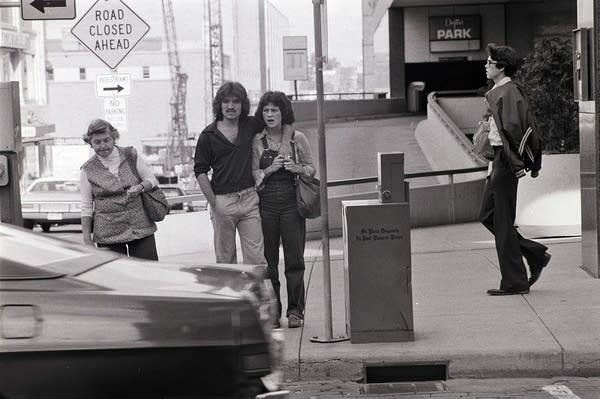The year downtown St. Paul 'died'

Go Deeper.
Create an account or log in to save stories.
Like this?
Thanks for liking this story! We have added it to a list of your favorite stories.
You might have been in a suburban multiplex watching "Star Wars" at the time — back when it was just "Star Wars."
But if you were in St. Paul in 1978, you were witness to a turning point in downtown, even if you didn't know it at the time. It was driven in part by a brief public transportation craze known as the "People Mover," proposed by the federal Urban Mass Transit Administration in 1975: think of an elevated airport-tram-like system that was going to circulate through downtown.

"Yes, 1978 ... The day downtown died," said architecture historian and critic Larry Millett — not entirely in jest.
The year is the subject of a new photography exhibit opening Thursday at the Landmark Center, in conjunction with Historic St. Paul and marking National Preservation Month. The exhibit is a series of 30 images from the late summer and fall of 1978 by Minneapolis photographer Jerry Mathiason — just a sample of about 800 photos he shot as potential illustrations of St. Paul for a proposal to build, and the state to fund, the controversial People Mover.
Turn Up Your Support
MPR News helps you turn down the noise and build shared understanding. Turn up your support for this public resource and keep trusted journalism accessible to all.

"There was a lot of push toward major developments in downtown St. Paul," Mathiason says of his work. "I have a lot of scenes with cranes in the background."

The photos include the Town Square development, called the "city within a city" built across Seventh street, which severed the historic commercial and retail spine of downtown. The development was to contain a shopping mall, a third-floor public park, and a proposed terminal for the People Mover.
Voters nixed the People Mover in 1980, leaving odd artifacts still visible: a diagonal slash left between the UBS Plaza and Bremer Tower office buildings downtown was to have accommodated the People Mover guideway, according to transit historian Aaron Isaacs.

Mathiason's photos show downtown just before the change. There are the last remnants of post-World War II retail — a camera shop on Wabasha, an appliance shop and an auto parts store on West Seventh Street. In one shot, a trio of elementary school-aged girls plays on the corner of Kellogg and Seventh, a testament to the easy access to downtown from nearby residential neighborhoods.
There are runners jogging down the old Wabasha Street bridge, aging department stores and vacant blocks cleared of 19th century buildings. Some of the photos show the city's then-incomplete skyway system, before foot traffic moved mainly indoors and up to the second level of downtown buildings.
"There was this gradual extinction of small buildings, which supported a lot of street level retail, and then the retail itself," said Millett.

Mathiason recognized the change but didn't entirely recognize the moment.
"I was just freelancing it. It was a lot of fun," Mathiason says. "I was just a year out of the University of Minnesota. In the 60s the big arts movement was street photography, and I did a lot of that. This allowed me to go back to this whole mode of what's going on and people interacting on the streets."
Some of those very streets are gone: Seventh Street was vacated for blocks, turned into private commercial space. Traffic was diverted onto Eighth Street, formerly a service corridor for the downtown core.
"In a sense, St. Paul is still struggling with those decisions. You've got the Rice Park area which is very nice, and they've got Lowertown, which is doing well, and then they've got this big blank middle which is just unpleasant for the most part," Millett says. "It was not St. Paul's finest hour, in terms of how this was all planned out."

The photography exhibit has an opening reception in Landmark Center at 5 p.m. Thursday and runs through May 26.
Admission is free and a panel discussion of the era, "We Were There: St. Paul, 1978," is scheduled for next Tuesday, from 12-1 p.m., in Courtroom 326, featuring Mathiason, then-mayor George Latimer and Macalester urban geography professor, David Lanegran.





